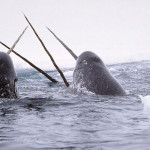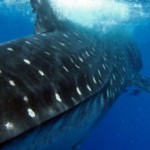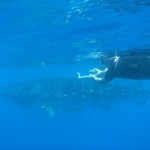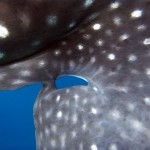While the announcer’s voice usually annoys me, I found this clip to be particularly interesting. They actually get into a nice little sidebar about the natural history of the fish that produce the eggs whale sharks like to eat. One thing I’ve always wanted to know is, why do they have the pattern of of dots and stripes on their back? Does it have a purpose? Can’t be camoflage, they are one of the biggest fish in the sea. Any ideas from our shark-savvy readership? What is the closest phylogenetic relative to the whale shark?
6 Replies to “Whale Shark Wine and Dine”
Comments are closed.






If you’re wondering “what’s this doing at DSN?”…
“Whale sharks dive to over 979.5 m, making primarily diurnal deep dives and remaining in relatively shallow waters at night.”
http://scienceblogs.com/deepseanews/2007/04/whale_sharks_do_it_deeper.php
Most elasmobranch phylogenies place whale sharks within Orectolobiformes (carpet sharks), which is a Galeomorph order along with Heterodontiformes (bullhead sharks), Lamniformes (mackerel sharks), and Carcharhiniformes (ground or whaler sharks). The idea of “closest phylogenetic relative” is a bit tricky, as it’s the only one in its family and genus.
No idea on the spots, although most of the other Orectolobiform species also have them — i.e., it could simply be a relict trait, perhaps?
From the Florida Museum of Natural History:
Juvenile whale sharks have this pattern too, and maybe it helps them avoid predation. There is a lot of research going on with these animal in Central America, where the locals refer to them as the domino fish.
Also, there is at least one albino whale shark out there that folks have taped on video: http://www.youtube.com/watch?v=nvUTexEGV4I
Oh yeah, and one last thing, the pattern is unique for each animal so researchers can use the spots to identify individuals. Rachel Graham was one of the first researchers to document the whale sharks feeding on snapper spawn off the coast of Belize.
Wilson, SG, and RA Martin. “Body Markings of the Whale Shark: Vestigial Or Functional?” WESTERN AUSTRALIAN NATURALIST 24.2 (2003): 115-17.
http://www.elasmo-research.org/publications/pdfs/whale_shark_pigmentation.pdf